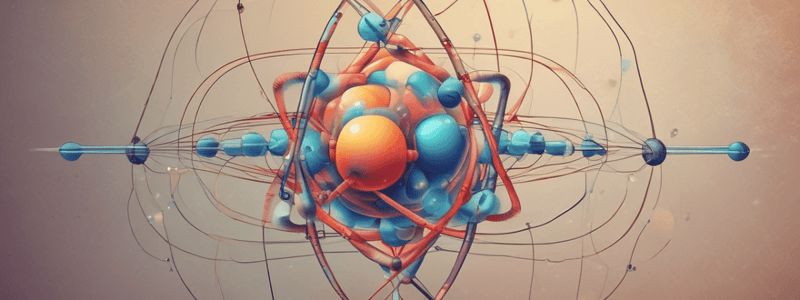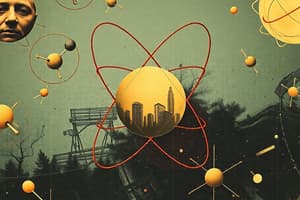Podcast
Questions and Answers
What is the location of subatomic particles such as protons and neutrons in a carbon atom?
What is the location of subatomic particles such as protons and neutrons in a carbon atom?
- Energy levels
- Electron cloud
- Nucleus (correct)
- Valence shell
What is the charge of a neutron?
What is the charge of a neutron?
- -1
- 0 (correct)
- +2
- +1
What is the major portion of an atom's mass composed of?
What is the major portion of an atom's mass composed of?
- Protons and electrons
- Electrons
- Energy levels
- Neutrons and protons (correct)
What is the atomic number of an element that determines its identity?
What is the atomic number of an element that determines its identity?
What is the charge of the nucleus in an atom of oxygen-17?
What is the charge of the nucleus in an atom of oxygen-17?
How many protons are in a neutral atom that contains 12 neutrons and 11 electrons?
How many protons are in a neutral atom that contains 12 neutrons and 11 electrons?
What is the mass number of a carbon atom that contains six protons, eight neutrons, and six electrons?
What is the mass number of a carbon atom that contains six protons, eight neutrons, and six electrons?
How many electrons occupy the second energy level of an atom at maximum?
How many electrons occupy the second energy level of an atom at maximum?
What is the characteristic of an element arranged in the Periodic Table?
What is the characteristic of an element arranged in the Periodic Table?
What is the characteristic of an alkali metal?
What is the characteristic of an alkali metal?
What is the number of valence electrons represented by the dots in the Lewis electron-dot diagram of a boron atom?
What is the number of valence electrons represented by the dots in the Lewis electron-dot diagram of a boron atom?
Which element has the highest electronegativity among Mg, Si, S, Cl?
Which element has the highest electronegativity among Mg, Si, S, Cl?
What is the correct balanced equation for the reaction of potassium with water?
What is the correct balanced equation for the reaction of potassium with water?
What is the characteristic of ionic compounds?
What is the characteristic of ionic compounds?
What is the correct method to calculate the mass of 2.10 moles of sodium chloride (NaCl)?
What is the correct method to calculate the mass of 2.10 moles of sodium chloride (NaCl)?
What is the characteristic of covalent compounds?
What is the characteristic of covalent compounds?
What is the correct method to calculate the number of moles of iron corresponding to 8.30 x 10²⁴ atoms?
What is the correct method to calculate the number of moles of iron corresponding to 8.30 x 10²⁴ atoms?
What is the correct method to calculate the mass of 1.30 x 10²³ molecules of glucose (C₆H₁₂O₆)?
What is the correct method to calculate the mass of 1.30 x 10²³ molecules of glucose (C₆H₁₂O₆)?
What is the correct method to calculate the number of oxygen atoms in 121.56 g of magnesium sulfite (MgSO₃)?
What is the correct method to calculate the number of oxygen atoms in 121.56 g of magnesium sulfite (MgSO₃)?
Which element is most readily to react with water based on metallic activity?
Which element is most readily to react with water based on metallic activity?
Flashcards are hidden until you start studying
Study Notes
Atomic Structure
- Subatomic particles in an atom's nucleus are protons and neutrons.
- Neutrons have a mass of 1 amu and no charge.
- All atoms of a given element have the same atomic number.
- The majority of an atom's mass comes from neutrons and protons.
- The atomic mass of an atom is measured in atomic mass units based on ¹²C.
Energy Levels and Electron Configuration
- The electrons in the first energy level of an atom possess the least amount of energy.
- The maximum number of electrons that can occupy the second energy level is 8.
- When energy is absorbed, electrons move to higher energy levels, and when energy is released, they move to lower energy levels.
- The bright-line spectrum of an element is produced when energy is released as electrons move to lower energy levels.
Periodic Table and Elements
- Elements are arranged in the Periodic Table in order of increasing atomic number.
- The element with chemical properties most similar to sodium is lithium.
- Alkali metals, such as Na, are found in Group 1.
- The group that contains elements composed of diatomic molecules is Group 17.
- A sample of an element that is malleable and can conduct electricity could be Sn.
- Nonmetallic solids are often brittle.
Chemical Bonding
- In an ionic bond, electrons are transferred from a metal to a non-metal.
- In a covalent bond, electrons are shared between two atoms.
- Ionic compounds typically have high melting and boiling points, conduct electricity, and are soluble in water.
- Covalent compounds usually have lower melting and boiling points, do not conduct electricity, and are often not soluble in water.
Chemical Reactions and Stoichiometry
- A balanced equation for the reaction of potassium with water is 2K + 2H₂O → 2KOH + H₂.
- A balanced equation for the reaction of aluminum with bromine is 2Al + 3Br₂ → 2AlBr₃.
- Combinations that are definitely chemical changes include those with observable evidence such as gas production, temperature change, or the formation of a precipitate.
- The molar mass of a compound is calculated based on the atomic masses of its constituent elements.
- The number of moles of a substance can be calculated using its molar mass and Avogadro's number.
Studying That Suits You
Use AI to generate personalized quizzes and flashcards to suit your learning preferences.




